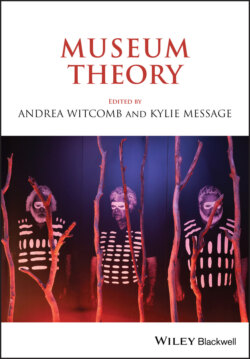Читать книгу Museum Theory - Группа авторов - Страница 19
Overview
ОглавлениеThe challenge we set for contributors to this volume was twofold. First, we wanted to devise a volume that would encourage conversation across the categories outlined by Parezo and across the distinctions proposed by Thomas. Second, we wanted to avoid the problem of a volume on museum theory being relentlessly concerned with the museum in general from the perspective of externally derived and high-level forms of abstraction. While we did not want to neglect this kind of theorizing altogether, we wanted to find a structure that enabled other kinds of theorizing to emerge. The details of this approach and how it has panned out through the volume are detailed in a following section, but included asking scholars from other disciplinary and theoretical fields to write about museums, and asking museum professionals to address the conditions for (and resistance to) theoretical reflexivity in the museum. As such, the volume represents an attempt to move beyond theoretically driven analyses of museums toward a situated form of theorizing about museums. Our starting point was to invite chapters that would theorize relationships between museums, knowledge, and experience and to devise a collection that would open up dialogue between museums and the academy, and probe links between museum studies and other disciplinary formations (such as cultural studies, art history, anthropology, natural history, and history) in ways that speak to the opportunities such conversations have both to theorize museums and also to use museums to do theoretical work.
Our editorial approach, then, has been to invite contributions that identify and probe specific kinds of conjunctures and points of praxis, rather than those that would interpret museums from the vantage point of particular theoretical frame-works, one after another. We are interested in the idea of the conjuncture and, by association, of “conjunctural knowledge” as that which is “situated in, and applica-ble to, specific and immediate political or historical circumstances; as well as an awareness that the structures of representations which form culture’s alphabet and grammar are instruments of social power, requiring critical and activist examina-tion” (During 1993, 97). This approach speaks effectively to the types of moments that the book presents, where constituents and collaborators (let alone museum professionals and other stakeholders) do not permit the theory or abstraction or traditions of detached critical distance to avoid the need to understand the felt specificities of the historical and contemporary empirical conditions pertinent to their museums.
To this end, the book has been framed around three themes: “Thinking about Museums,” “Disciplines and Politics Disciplines and Politics,” and “Theory from Practice/ Practicing Theory.” In “Thinking about Museums” we have gathered work focused on understanding the nature of museums as institutions and their role in the public sphere. While these contributions mostly start from theory, they are always responsive to particular historical conjunctures, situating museums in response to the history of ideas or particular political and sociological conjunctures or, alternatively, wanting to completely reconceptualize the philosophical basis on which we think about museums and their collections in the first place. Part II, “Disciplines and Politics,” presents work by scholars based in specific disciplines and with particular theoretical orientations whom we have asked to consider contemporary museums from the point of view of those interests. These chapters both reflect and generate a conversation between museums and specific kinds of knowledge–such as those produced by disciplines such as art history, history, anthropology, and science–as well as by specific types of research questions such as inquiries into the relationship between museums and the public sphere and museums and the formation of subjectivity. Part III, “Theory from Practice/Practicing Theory,” includes chapters by scholars whose work begins with (and often in) museums but reaches out to and across a range of disciplines in an attempt to theorize, better understand, and challenge what is going on both in museums and in relation to the disciplinary frameworks within which their work is located. This section includes contributions by museum practitioners at the cutting edge of museum practice, many of whom are making innovative connections between their practice and current global concerns.
As this overview illustrates, the volume has been devised to offer critical perspectives on the museum (as an institution) and on museums (as a series of individual specificities and contingencies) from a range of disciplinary and intellectual traditions. The concerns of our contributors are transnational and the volume includes discussion and analysis of a wide variety of different kinds of museums from various national and local contexts. It is also predominantly contemporary in focus. Although we have not excluded past practices, where they are included they have been investigated and assessed from the vantage point of the present such that the emphasis of contributors has been on identifying how particular moments in theory have impacted on museums; how particular moments in museum practices have been theorized; and what kind of impact these moments have each had on museums. In the following section we elaborate further on our interest inthepolitics of crisis and conjuncture which can lead to contextual, theoretical, and pragmatic changes in the way museums work, and are understood and experienced.
